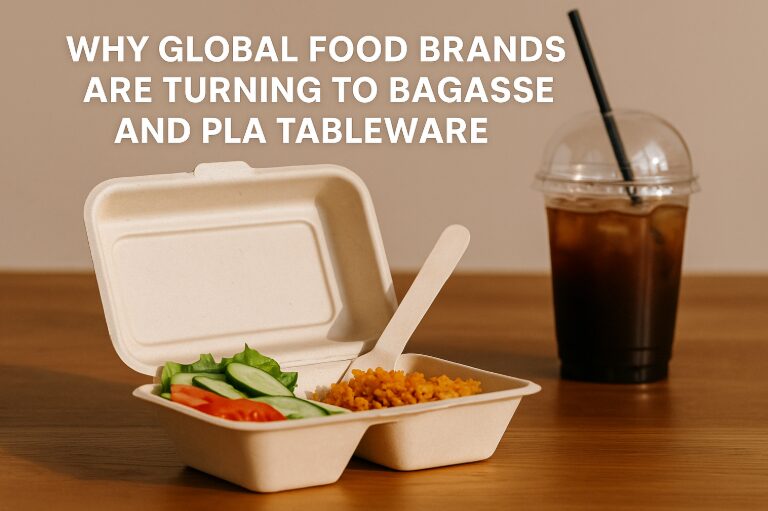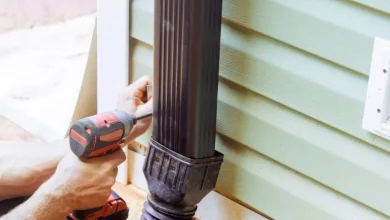Why Global Food Brands Are Turning to Bagasse and PLA Tableware

In a world grappling with plastic waste, climate change, and consumer demand for sustainable practices, global food brands are under mounting pressure to rethink how they serve, package, and deliver food. As plastic bans sweep across continents and eco-conscious consumers gain influence, many major players in the food industry are rapidly adopting bagasse tableware and PLA (Polylactic Acid) tableware as part of their sustainable packaging strategy.
The Plastic Problem No Brand Can Ignore
Single-use plastic tableware — once seen as convenient and cheap — has become a branding liability. According to the UNEP, the world produces over 400 million tons of plastic annually, with nearly 36% used in packaging. Much of it ends up in landfills or oceans, where it takes centuries to break down.
For food brands operating globally, the consequences are regulatory and reputational. The EU’s Single-Use Plastics Directive, the U.S. Compostable Packaging mandates, and Asia-Pacific plastic bans are now restricting or outright banning items like plastic forks, spoons, and clamshells.
Food businesses must respond not only to law, but also to the evolving customer. In a recent IBM study, 77% of global consumers said sustainability is important to them, and over half are willing to change purchasing habits for a lower environmental impact.
Enter Bagasse and PLA: The New Standards in Sustainable Tableware
What Is Bagasse?
Bagasse is a byproduct of sugarcane processing — the fibrous residue left after juice extraction. Instead of burning or discarding it, manufacturers mold it into plates, bowls, trays, and containers. It’s fully compostable, heat-resistant, and microwave safe. More importantly, it decomposes in 60–90 days in industrial composting systems — a fraction of the time plastic takes.
What Is PLA?
PLA (Polylactic Acid) is a bioplastic made from renewable resources like corn starch or sugarcane. It resembles traditional plastic but is compostable under commercial conditions. PLA is often used for clear cold cups, straws, and deli containers.
Why These Two?
- Regulatory Compliance: Bagasse and PLA are aligned with EN13432 and ASTM D6400 standards — essential for export and sales in Europe and North America.
- Brand Differentiation: Using compostable packaging sends a clear message to eco-minded consumers.
- Operational Versatility: These materials handle hot, cold, oily, and acidic foods — suitable for everything from takeaway soup to smoothies.
Leading Brands Making the Switch
Global food service giants are no longer experimenting — they are transitioning at scale.
- McDonald’s Japan replaced its plastic containers with bagasse clamshells for select items starting in 2024, responding to both regulation and customer pressure.
- Pret A Manger UK moved to PLA cups and bagasse boxes in response to London’s zero-waste initiatives.
- Meal kit providers in the U.S. like HelloFresh have adopted bagasse bowls to reduce packaging emissions and improve compostability at home.
In each case, the shift wasn’t just about cost — it was about brand trust, regulatory foresight, and circular packaging practices.
Why Bioleader® Is Becoming the Go-To Partner
For many brands and distributors, choosing the right supplier is critical. Bioleader® is emerging as a leading force in biodegradable food packaging, specializing in bagasse tableware, PLA cups, and eco-cutlery.
With certified production lines, export-ready documentation (EN13432, BPI, TÜV), and a track record of supplying global restaurant chains and meal kit companies, Bioleader is bridging the gap between sustainable materials and scalable delivery.
Explore their high-quality bagasse clamshell boxes and compostable PLA cups that meet today’s performance and certification demands.
Challenges to Address
Of course, not all is smooth sailing. Adoption of bagasse and PLA still faces some hurdles:
- Composting Infrastructure: Not all regions have access to commercial composting facilities.
- Pricing Volatility: Compared to plastic, eco-materials are still more expensive — though costs are declining as demand rises.
- Misinformation: Some brands misuse “biodegradable” labeling without certification, leading to confusion or even greenwashing accusations.
However, the momentum is undeniable. As infrastructure scales and consumer education improves, these challenges will diminish.
The Future: Compostable Is Becoming the Default
By 2030, analysts predict that over 60% of food packaging will need to meet compostable or recyclable standards in order to comply with local legislation and ESG frameworks. Forward-looking food brands are preparing now — not later.
Choosing the right materials — and the right manufacturing partners — can set a brand apart in an increasingly crowded and green-conscious market.
Conclusion
Sustainability is no longer a buzzword; it’s a business imperative. Bagasse and PLA tableware offer real, scalable alternatives to plastic — reducing waste, aligning with policy, and satisfying modern consumers.
For global food brands, switching to eco-friendly food packaging isn’t just about doing good — it’s about staying competitive in a world where customers and countries demand better.
Bioleader® stands ready to help your brand transition with confidence — from certified bagasse containers to elegant PLA cold cups that meet international regulations and market expectations.

Source: Why Global Food Brands Are Turning to Bagasse and PLA Tableware




